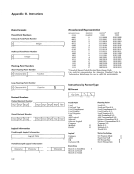interruption for the significance exception does not
occur; rather, the characteristic is made zero, yielding
a true zero result. Exponent underflow does not occur
for a zero fraction.
The sign of the sum is derived by the rules of
algebra. The sign of a sum with zero result fraction
is always positive.
ResultingCondition Code: o Result fraction is zero
1 Result is less than zero
2 Result is greater than zero
3 Result exponent overflows
Program Interruptions:
Operation (if floating-point feature is not in-
stalled)
Addressing (AE and AD only)
Specification
Significance
Exponent overflow
Exponent underflow
Programming Note
Interchanging the two operands in a floating-point
addition does not affect the value of the sum.
AddUnnormalized AUR RR (Short Operands) I 3E Rl I R2 I 0 78 11 12 15
AU RX (Short Operands)I 7E Rl I X
2I B2 D2 0 78 11 12 1516 1920 31
AWR RR (Long Operands)I 2E Rl I R2 I 0 78 11 12 15
AW RX (Long Operands)I 6E Rl I X
2I B2 0 78 11 12 1516 1920 31
The second operand is added to the first operand, and
the unnormalized sum is placed in the first operand
location.
In short-precision, the low-order halves of the float
ing-point registers are ignored and remain unchanged.
After the addition the intermediate sum is truncated
to the proper fraction length.
When the resulting fraction is zero and the signifi
cance mask bit is one, a significance exception exists
and a program interruption takes place. When the
resulting fraction is zero and the significance mask
bit is zero, the program interruption for the signifi
cance exception does not occur; rather, the character
istic is made zero, yielding a true zero result.
Leading zeros in the result are not eliminated by
normalization, and an exponent underflow cannot
occur.
The sign of the sum is derived by the rules of
algebra. The sign of a sum with zero result fraction is
always positive.
ResultingCondition Code: o Result fraction is zero
1 Result is less than zero
2 Result is greater than zero
3 Result exponent overflows
Program Interruptions:
Operation (if floating-point feature is not in-
stalled)
Addressing(AU and A w
only)
Specification
Significance
Exponent overflow
SubtractNormalized SER RR (Short Operands) I 3B Rl I R2 I 0 78 11 12 15 SE RX (Short Operands) I 7B Rl I X
2I B2 D2 0 78 11 12 1516 1920 31 SDR RR (Long Operands) I 2B Rl I R2 I 0 78 11 12 15 SD RX (Long Operands)
6B
7 8 11 12 15161920 31
The second operand is subtracted from the first op
erand, and the normalized difference is placed in thefi'rst operand location.
Floating-Point Arithmetic 45
occur; rather, the characteristic is made zero, yielding
a true zero result. Exponent underflow does not occur
for a zero fraction.
The sign of the sum is derived by the rules of
algebra. The sign of a sum with zero result fraction
is always positive.
Resulting
1 Result is less than zero
2 Result is greater than zero
3 Result exponent overflows
Program Interruptions:
Operation (if floating-point feature is not in-
stalled)
Addressing (AE and AD only)
Specification
Significance
Exponent overflow
Exponent underflow
Programming Note
Interchanging the two operands in a floating-point
addition does not affect the value of the sum.
Add
AU RX (Short Operands)
2
AWR RR (Long Operands)
AW RX (Long Operands)
2
The second operand is added to the first operand, and
the unnormalized sum is placed in the first operand
location.
In short-precision, the low-order halves of the float
ing-point registers are ignored and remain unchanged.
After the addition the intermediate sum is truncated
to the proper fraction length.
When the resulting fraction is zero and the signifi
cance mask bit is one, a significance exception exists
and a program interruption takes place. When the
resulting fraction is zero and the significance mask
bit is zero, the program interruption for the signifi
cance exception does not occur; rather, the character
istic is made zero, yielding a true zero result.
Leading zeros in the result are not eliminated by
normalization, and an exponent underflow cannot
occur.
The sign of the sum is derived by the rules of
algebra. The sign of a sum with zero result fraction is
always positive.
Resulting
1 Result is less than zero
2 Result is greater than zero
3 Result exponent overflows
Program Interruptions:
Operation (if floating-point feature is not in-
stalled)
Addressing
only)
Specification
Significance
Exponent overflow
Subtract
2
6B
7 8 11 12 1516
The second operand is subtracted from the first op
erand, and the normalized difference is placed in the
Floating-Point Arithmetic 45









































































































































































